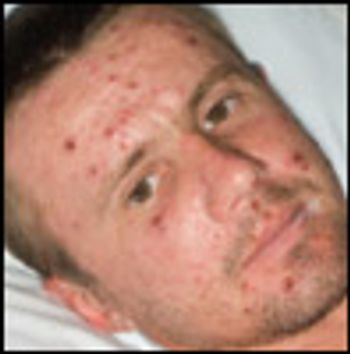
A 29-year-old Ukrainian man presents with a mildly pruritic generalized rash, which started 4 days earlier as a widespread eruption. The patient has no contacts who have a similar rash.

A 29-year-old Ukrainian man presents with a mildly pruritic generalized rash, which started 4 days earlier as a widespread eruption. The patient has no contacts who have a similar rash.
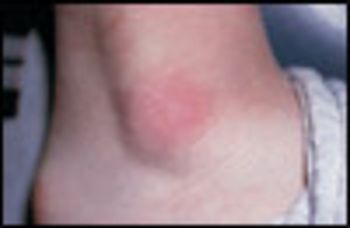
During a routine checkup, a 14-year-old girl inquires about a large red spot on her right ankle. The asymptomatic, erythematous area overlying the malleolus has been present for several months.

In adults who present with persistent cough following an upper respiratory tract infection but who have no history of asthma or chronic obstructive pulmonary disease, lung findings are usually “normal” on auscultation.

A 71-year-old African American man presented to the emergency department (ED) with chest pain, dyspnea, and hemoptysis. He had had a few ED visits for similar symptoms within the previous 4 weeks.

How effective is antibiotic therapy for long-standing reactive arthritis?

Here Dr Scheinfeld provides a pictorial guide to neurotic excoriation, perforating folliculitis, chondrodermatitis nodularis chronica helicis, hyperkeratosis, and intertrigo.

A universal vaccine that protects against all strains of influenza virus may eventually replace yearly seasonal flu shots. This vaccine has been shown to be effective in animals, report investigators from the National Institute of Allergy and Infectious Diseases (NIAID).
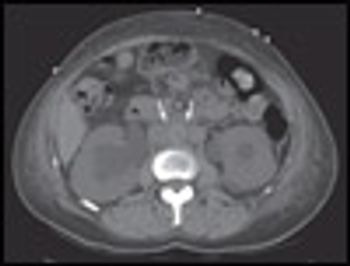
For about 2 weeks, a 61-year-old woman with diet-controlled diabetes and hypertension had fatigue and generalized weakness. For the past 3 months, she had had poorly localized back pain and bilateral flank pain. She denied dysuria, fever, decreased urinary output, or weight loss.

The patient has a history of hospital admissions for complications of alcoholism, including pancreatitis and trauma from falls. What's your diagnosis?
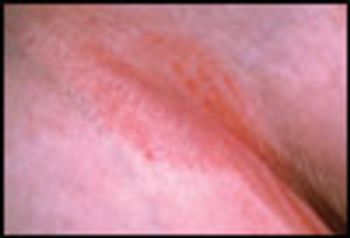
An obese 60-year-old woman presents with a chronic malodorous, itchy rash in her groin.

A 65-year-old man, who was lost to follow-up after abdominal-perineal resection for rectal adenocarcinoma 9 months earlier, presents with progressively worsening neurological symptoms, including bilateral hearing loss, dizziness, gait disturbance, ataxia, and blindness in the right eye.

For 2 days, a 54-year-old woman had an asymptomatic red patch on the left anterior distal lower extremity. In the center of the lesion was an erosion where a flaccid blister had broken. She had experienced 2 previous episodes in which an identical lesion had appeared in the same location. These episodes had been preceded by a urinary tract infection for which she received trimethoprim/sulfamethoxazole.
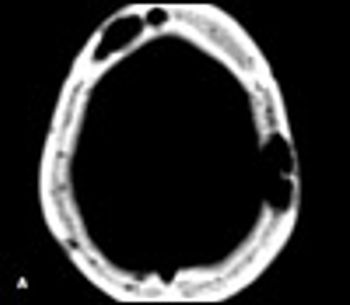
A39-year-old man with a history of AIDS and nonadherence to highly active antiretroviral therapy (HAART) presented with frontal headache and scalp pain of 2 weeks' duration. These symptoms were accompanied by nausea, weight loss, and generalized weakness. Physical examination revealed a small, tender scalp lump, 2 × 2 cm over the left parietal area. The findings from the rest of the examination were unremarkable.
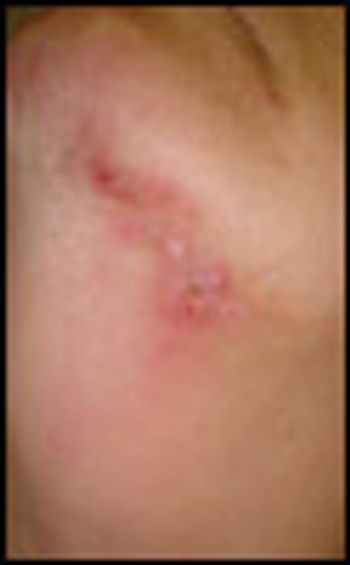
For more than a year, a 65-year-old woman had a nonpainful but nonhealing erythematous papule in the left submandibular area. She denied any unusual exposures or work history. Her most recent dental examination was several years earlier.

Match the following characteristics with the clinical disorders pictured in the photographs of Cases 1 and 2. Then read the brief descriptions that follow on the next page to see how well you did.
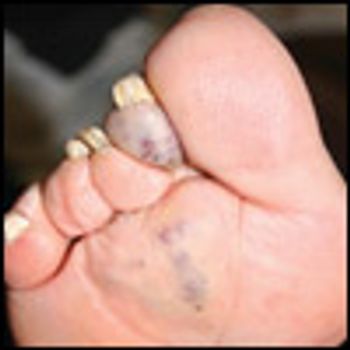
The plantar aspect of this toe shows purple nonuniform darkening that mimicked either a simple traumatic hematoma or the blue toe syndrome. More proximally, however, the solar aspect contained irregular dark-purple dots reminiscent of individual thrombosed venules, and in addition showed discontinuous purple zones more proximally in the part of the ray that lay within the body of the foot and that surely could not be imputed to any possible toe trauma or fracture nor to ischemia in the distribution of any single vessel. No purple area was warm or tender.

Nitrofurantoin has been widely used for the treatment and prevention of recurrent urinary tract infections since its introduction into clinical practice in 1953. Although it continues to be an effective antibiotic, nitrofurantoin is associated with several adverse effects, including pulmonary toxicity.

Because epidermal integrity decreases with age, eczematous inflammatory dermatoses are more common among older adults than among younger persons.
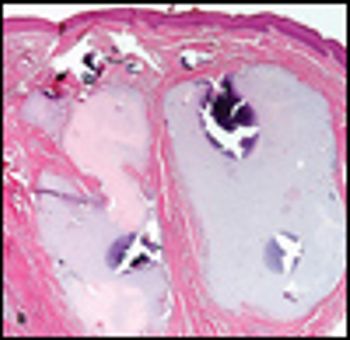
These lesions on the scrotum of an otherwise healthy 42-year-old man had gradually increased in size and quantity over the past 3 to 4 years. The firm, skin-colored papules and nodules ranged in size from 0.8 to 2 cm. The lesions caused occasional discomfort and itching. No inguinal rash or urethral discharge was noted. There was no sign of a hernia, and both testes were in the scrotum.

A 43-year-old white man presented to the emergency department with dyspnea, abdominal bloating, fever with chills, night sweats, decreased oral intake, and myalgia of 1 week's duration. He was found to have heart failure caused by systolic dysfunction. Viral myocarditis was the presumptive diagnosis after investigation for other causes.
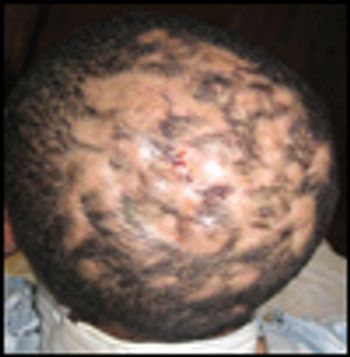
For the past 7 years, a 32-year-old African-American man had multiple nonpruritic scalp abscesses. He also reported intermittent fever and joint pain. The abscesses had been drained on many occasions, and he had received several antibiotics, although no organisms had been isolated. Collagen vascular disease, SAPHO syndrome (synovitis, acne, pustulosis, hyperostosis, osteitis), discoid lupus, and cutaneous sarcoid had been ruled out. During the past 7 years, he had been treated with prednisone, methotrexate, and hydroxychloroquine without any response.

We published a question from John Mosby, MD, who wanted to know why the zoster vaccine had been administered to an older man in an earlier Photoclinic case who had ophthalmic zoster. We also published the response from Dr Tran, which cited the Advisory Committee on Immunization Practices (ACIP) recommendation to administer the vaccine to all patients 60 years or older in whom it is not contraindicated, including those with a history of previous zoster.

Two of the numerous geriatrics offerings at this year’s ACP convention were part of a series entitled “Modifying Your Office Practice for the Tsunami of Older Adults.” This eminently apropos title was actually something of a theme for the convention as a whole. This year, only 3 clinical categories boasted more offerings than geriatrics. Clearly, primary care physicians are beginning to feel the impact of the baby boomers’ coming of age.

Michael F. Holick, MD, PhD, the Boston University professor of medicine and well-known “apostle of vitamin D,” attracted a standing-room-only crowd Friday for a presentation on his favorite topic. It was a performance that had the audience at rapt attention for a full hour-not just because of the celebrity of the speaker, but because of the extraordinarily clever and engaging nature of his presentation.

Probiotics and prebiotics are now widely used by patients – and even present in many common foods.